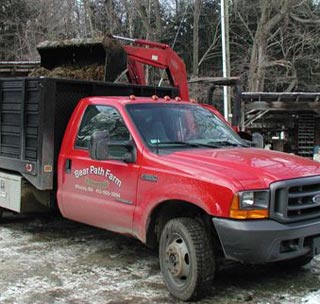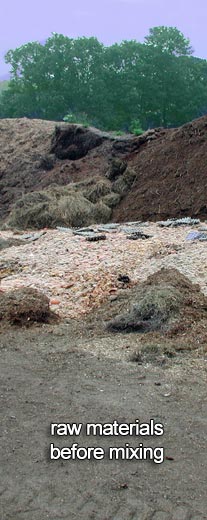 To produce compost on a commercial scale one needs land for a compost pad (soil or paved), additional land for receiving and storing raw materials, equipment for moving, mixing and turning the materials, large quantities of compostable material (some high in carbon and the rest high in nitrogen), and trucks for delivering the finished product to customers.
To produce compost on a commercial scale one needs land for a compost pad (soil or paved), additional land for receiving and storing raw materials, equipment for moving, mixing and turning the materials, large quantities of compostable material (some high in carbon and the rest high in nitrogen), and trucks for delivering the finished product to customers.
Horse bedding (horse manure mixed with wood shavings or sawdust) is the primary source of high carbon material used in the composting process at Bear Path Compost. Most of this bedding is delivered from the Northampton Three County Fairgrounds that annually hosts many major horse shows. Leaves, spoiled hay and short paper fiber (SPF) are also used as high carbon material in our recipes.. Manure (a high nitrogen material) is purchased from a local dairy farm and delivered to the compost receiving area. Food waste, another high nitrogen material is routinely picked up at the Whately Elementary School. Additional source separated food waste is delivered regularly from the Whately transfer station.
A ratio of approximately 30 parts of carbon to one part nitrogen is required for a good compost mix. Bear Path Compost uses a John Deere articulated front end loader with a 2 cubic yard bucket for most of the mechanical composting activities – moving, mixing, turning and loading. The composting process begins when the loader is used to layer the high carbon and high nitrogen materials in a pile – bedding then manure / food waste for a total of 9 buckets - 3 (manure / food waste) and 6 (horse bedding / old hay / short paper fiber / leaves). Approximately 3% (1/2 yd) of high carbon wood ash is also added to the compost mix to protect against potential herbicide contamination from feedstocks. High carbon wood ash is widely used by all significant compost producers in Vermont. These materials are thoroughly mixed in place with the loader and then transported one bucket at a time to start or add to a windrow.
All windrows are labeled to keep track of when they were made, their ingredients, and their dates of turning. Windrows are turned about every 3 to 4 weeks several times over the course of 9 months to a year. In the beginning a typical windrow contains about 360 cubic yards of composting materials. At the end of the composting cycle, this volume will be reduced by almost 45% leaving about 200 cubic yards of finished compost. Throughout the composting process, temperatures are periodically checked to assure proper thermophilic (high temperature) microbial activity. High temperatures and timely turning assure the destruction of weed seeds and pathogens. At the end of curing, the last slow stage of decomposition, the compost is considered stable and ready for use by our customers. The end result is a dark, rich, humus-like product with an excellent balance of nutrients, a slightly alkaline pH, and a cornucopia of microorganisms that greatly benefit the soil.


